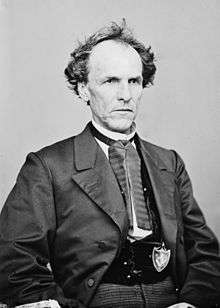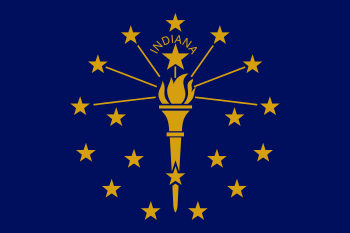James Henry Lane (Union general)
| James Henry Lane | |
|---|---|
 | |
| United States Senator from Kansas | |
|
In office April 4, 1861 – July 11, 1866 | |
| Preceded by | (none) |
| Succeeded by | Edmund G. Ross |
| Member of the U.S. House of Representatives from Indiana's 4th district | |
|
In office March 4, 1853 – March 3, 1855 | |
| Preceded by | Samuel W. Parker |
| Succeeded by | William Cumback |
| 11th Lieutenant Governor of Indiana | |
|
In office December 5, 1849 – January 10, 1853 | |
| Governor | Joseph A. Wright |
| Preceded by | Paris C. Dunning |
| Succeeded by | Ashbel P. Willard |
| Personal details | |
| Born |
June 22, 1814 Lawrenceburg, Indiana Territory |
| Died |
July 11, 1866 (aged 52) Leavenworth, Kansas |
| Political party | Republican |
| Spouse(s) | Mary E. Lane |
| Military service | |
| Allegiance | United States of America |
| Service/branch |
United States Army Union Army |
| Years of service | 1846–1848, 1861–1862 |
| Rank |
|
| Battles/wars |
Mexican–American War American Civil War |
James Henry Lane, also known as Jim Lane, (June 22, 1814 – July 11, 1866) was a partisan during the Bleeding Kansas period that immediately preceded the American Civil War. During the war itself, Lane served as a United States Senator and as a general for the Union. Although reelected as a Senator during 1865, Lane committed suicide the next year.
Biography
The son of Amos Lane, Lane was born in Lawrenceburg, Indiana,[1] where he practiced law when he was admitted to the state bar during 1840. During the Mexican–American War, he successively commanded the 3rd and 5th Indiana Regiments. He was a U.S. congressman from Indiana (1853–1855) where he voted for the Kansas–Nebraska Act.
He relocated to the Kansas Territory during 1855. He immediately became involved with abolitionism in Kansas, and was often termed the commander of the Free State Army ("The Red Legs" or Jayhawkers), a major Free Soil militant group. In 1855 he was the president of the convention that drafted the anti-slavery Topeka Constitution. After the Free Soilers succeeded in getting Kansas admitted to the Union during 1861 as a free state, Lane was elected as one of the new state's first U.S. Senators, and reelected during 1865
Civil War
During the American Civil War, in addition to his Senate service, Lane formed a brigade of "Jayhawkers" known as the "Kansas Brigade", or "Lane's Brigade", composed of the Third, Fourth, and Fifth Kansas Volunteers. He commanded this force into action against pro-Southern General Sterling Price of Missouri in the Battle of Dry Wood Creek, as Price began an offensive early in the War to retake Missouri for the pro-Confederate state government that had been deposed by pro-Union forces around St. Louis. Lane lost the battle but stayed behind and attacked pro-South areas in Missouri behind Price. During the Battle of Hemp Bales, General John Charles Fremont ordered General Henry Lane to make a " demonstration along the Kansas Missouri border with his Jayhawkers". Lane acted gladly on Fremont's official authorization for a raid into Missouri.He raided the village of Morristown near the state line, burned it and swept a wide path of pillage,arson and murder of private citizens through the Missouri territory six miles wide and fifteen miles long.However as it turns out it had little to no effect on Mulligan.[2] " His raids culminated in the Sacking of Osceola, in which Lane's forces killed at least nine men, then pillaged, looted, and then burned the town; these events inspired the novel Gone To Texas by Forrest Carter, which was the basis for the 1976 Clint Eastwood movie The Outlaw Josey Wales. Lane was criticized for his violence in Osceola, most severely by General Henry Halleck, then Commander of the Department of Missouri. Of their actions, he would state: "The course pursued by those under Lane and Jennison has turned against us many thousands who were formerly Union men. A few more such raids will make this State unanimous against us." Thus, Lane's Brigade was ended.[3]
On December 18, 1861 Lane was appointed brigadier general of volunteers. On March 21, 1862, his commission was canceled in culmination of an argument over whether a sitting U.S. Senator could concurrently have the rank of General.[4] However, on April 11, 1862, he was reinstated as brigadier general of volunteers with the confirmation of the U.S. Senate. During 1862–1863, he served as recruiting commissioner for the State of Kansas.
On October 27–29, 1862, U.S. Senator Jim Lane recruited the 1st Regiment Kansas Volunteer Infantry (Colored) who debuted at the Skirmish at Island Mound. They are the first African-American troops to fight in the war, a year before the 54th Massachusetts. In their first action, 30 of their members defeated 130 mounted Confederate guerrillas.[5]
Lane was the target of the event that became the Lawrence Massacre (or Quantrill's Raid) on August 21, 1863. Confederate guerrillas could be heard shouting, "Remember Osceola!" Though Lane was in residence in Lawrence at the time, he was able to escape the attack by racing through a nearby ravine.
During 1864 when Sterling Price invaded Missouri, Lane served as a volunteer aide-de-camp to Samuel R. Curtis, commander of the Army of the Border. Lane was with the victorious Union forces at the battle of Westport.
Death and legacy
On July 1, 1866 Lane shot himself[6] in the head as he jumped from his carriage in Leavenworth, Kansas. He was allegedly deranged, depressed, had been charged with abandoning his fellow Radical Republicans and had been accused of financial irregularities. He died ten days later near Leavenworth, Kansas, a result of the self-inflicted gunshot. Edmund G. Ross was appointed to succeed him in the Senate.
The following places were named in honor of the late senator:
In popular culture
- Jim Lane appears as a character in Wildwood Boys (William Morrow, New York; 2000), a biographical novel of Bloody Bill Anderson by James Carlos Blake.
- Jim Lane is a main character in the new book, "The 116" by James P. Muehlberger.
See also
References
| Wikimedia Commons has media related to James Henry Lane. |
- ↑ "James Henry Lane". NNB. Retrieved September 26, 2012.
- ↑ The Army of Tennessee p. 31
- ↑ James H. Lane - Grim Leader in the Free-State Fight
- ↑ Eicher p.338
- ↑ Border War Timeline, 1861 - 1865: The Civil War
- ↑ "OBITUARY.; James H. Lane, United States Senator from Kansas". The New York Times. July 4, 1866. Retrieved 13 June 2009.
- ↑ Gannett, Henry (1905). The Origin of Certain Place Names in the United States. Government Printing Office. p. 180.
External links
- United States Congress. "James Henry Lane (id: L000061)". Biographical Directory of the United States Congress. Retrieved on 2008-02-19
- "James Henry Lane". Find a Grave. Retrieved 2008-02-19.
- James H. Lane at Territorial Kansas Online
- James H. Lane at PBS: New Perspectives on The West
- James H. Lane at NNDB
- James H. Lane at Downfall Dictionary
- James H. Lane at Mr. Lincoln's White House
- Senator Jim at Bull Run
| Political offices | ||
|---|---|---|
| Preceded by Paris C. Dunning |
Lieutenant Governor of Indiana 1849 – 1853 |
Succeeded by Ashbel P. Willard |
| U.S. House of Representatives | ||
| Preceded by Samuel W. Parker |
Member of the U.S. House of Representatives from Indiana's 4th congressional district March 4, 1853 – March 3, 1855 |
Succeeded by William Cumback |
| U.S. Senate | ||
| Preceded by (none) |
U.S. Senator (Class 2) from Kansas March 4, 1861 – July 11, 1866 Served alongside: Samuel C. Pomeroy |
Succeeded by Edmund G. Ross |



